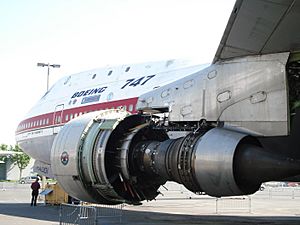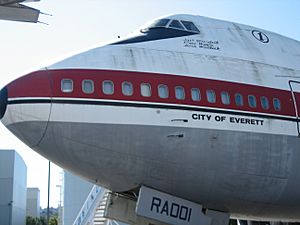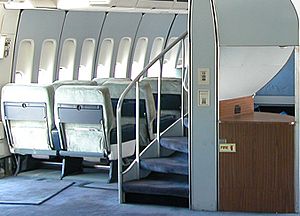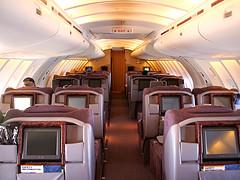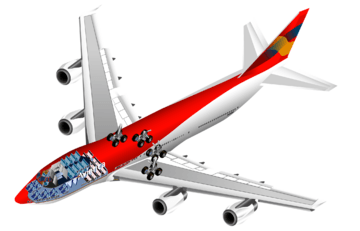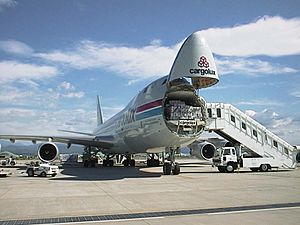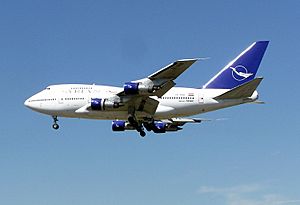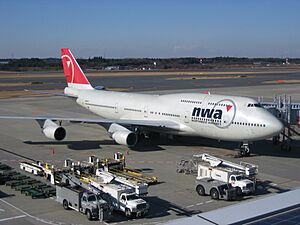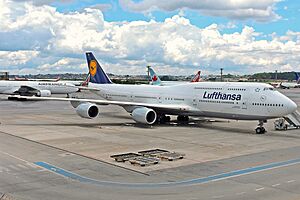Boeing 747 facts for kids
Quick facts for kids Boeing 747 |
|
|---|---|
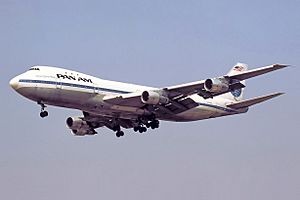 |
|
| A Boeing 747-100 | |
| Role | Wide-body, long-range jet airliner |
| National origin | United States |
| Manufacturer | Boeing Commercial Airplanes |
| First flight | February 9, 1969 |
| Introduction | January 22, 1970 with Pan Am |
| Status | No longer produced but used by airlines |
| Produced | 1968–2022 |
| Number built | 1,458 as of December 2012[update] |
| Unit cost | 747-100: US $24 million (1967) 747-200: US $39 million (1976) 747-300: US $83 million (1982) 747-400: US $228–260 million (2007) 747-8I: US $351 million 747-8F: US $352 million |
| Variants | Boeing 747SP Boeing 747-400 Boeing 747-8 Boeing VC-25 Boeing E-4 |
| Developed into | Boeing YAL-1 Boeing Dreamlifter |
The Boeing 747 is a very famous jet plane made by Boeing in 1969. It's built by Boeing Commercial Airplanes. The 747 is known as a "wide-body" aircraft because it has more than one aisle inside. People often call it the Jumbo Jet or Queen of the Skies because it's so big and well-known. It was the first wide-body plane ever built.
The first 747 was two and a half times bigger than the Boeing 707. It started flying for airlines in 1970. For 37 years, the 747 could carry more people than any other plane. Then, the Airbus A380 was made, which is even bigger.
The 747 is a double-deck plane. It can carry passengers, cargo, and many other things. Boeing designed the upper deck to be a special area, like a first-class lounge or extra seats. They also made it easy to change the plane into a cargo (freight) plane. This was done by removing seats and adding a large cargo door at the front. Boeing thought that super-fast planes (supersonic airliners) would become more popular for passengers. But they believed that large cargo planes would always be needed.
People thought the 747 would stop being popular after about 400 were sold. But it stayed popular, and over 1,000 planes were made by 1993. By September 2012, 1,448 aircraft had been built. The 747-400 is one of the fastest airliners flying today. It usually flies at about Mach 0.85 (which is around 570 miles per hour). It can fly for about 7,260 nautical miles (8,350 miles or 13,450 km). The very last version of the 747, the 747–8, stopped being made in December 2022. The 747 will eventually be replaced by a new Boeing plane called the Boeing Y3.
| Top - 0-9 A B C D E F G H I J K L M N O P Q R S T U V W X Y Z |
How the 747 Was Developed
Starting the Idea
In 1963, the United States Air Force wanted a very big plane to transport military supplies. They were using the Lockheed C-141 Starlifter, but they needed something much larger. This new plane was called the CX-Heavy Logistics System (CX-HLS). It needed to carry 180,000 pounds (81,600 kg) of cargo. It also had to fly at Mach 0.75 (about 500 mph or 800 km/h). The plane needed to fly 5,000 nautical miles (9,260 km) while carrying 115,000 pounds (52,100 kg) of cargo. The cargo area had to be 17 feet (5.2 m) wide, 13.5 feet (4.1 m) high, and 100 feet (30 m) long. It also needed doors at both the front and back.
The Air Force also wanted the plane to have only four engines. This meant new, powerful engines had to be created. Several companies, including Boeing, designed planes. Other companies like General Electric and Pratt & Whitney designed the engines. In 1965, Lockheed's plane design and General Electric's engines were chosen for the C-5 Galaxy. At that time, it was the biggest military cargo plane in the world.
Becoming a Passenger Plane
The idea for the 747 passenger plane came about in the 1960s. Planes like the Boeing 707 made long-distance travel much easier. Juan Trippe, who ran Pan American World Airways (Pan Am), asked Boeing to build a plane more than twice the size of the Boeing 707. Airports were very busy back then, and Trippe thought a bigger plane could help reduce traffic.
In 1965, Joe Sutter was put in charge of designing this new plane, which was named the 747. Sutter asked Pan Am and other airlines what they wanted in the plane. At the time, many thought that super-fast planes would replace the 747. Because of this, Boeing designed the 747 so it could easily be changed into a cargo plane. This way, if passenger flights became less popular, it could still be used for freight.
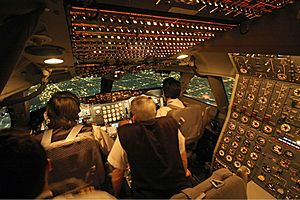
In April 1966, Pan Am ordered 25 of the first 747-100 planes. This order cost US$525 million. Since Pan Am was the first airline to order the plane, they had a big say in how the 747 was designed and built. No other airline before or since has had so much say over a plane's design.
Designing the Plane
The first design Boeing made for the Air Force in 1963 was not used for the 747. However, Boeing used some new ideas from that project. The first 747 design had two full decks for passengers. But in 1966, this was changed to only one main deck. The cockpit was placed above the main deck, which created the plane's famous "hump." There was a small space behind the cockpit where people could sit. At first, it was a "lounge" area without fixed seats.
Planes as big as the 747 needed special engines called high-bypass turbofan engines. These engines are much more powerful than older "turbojet" engines. They also use a lot less fuel. General Electric was making the first of these engines for the C-5 Galaxy military plane. Pratt & Whitney was also working on this type of engine. In 1966, Boeing, Pan Am, and Pratt & Whitney worked together to design a new engine, the JT9D, specifically for the 747.
Boeing used special devices to help the plane get more lift. This helped the 747 take off from shorter runways. The 747 has many flaps on its wings. When these flaps are used, they make the wings 21 percent bigger. They also create 90 percent more lift, helping the plane get into the air.
Boeing aimed to deliver the first 747 to Pan Am by the end of 1969. This meant Boeing only had 28 months to design the entire aircraft. The people who worked on the 747 were nicknamed "The Incredibles" because of how fast they had to work.
Building the Factory
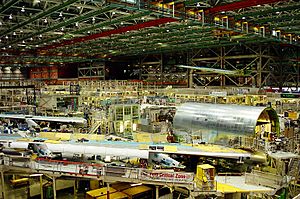
Boeing did not have a factory big enough to build the new 747. They looked at 50 different cities for a new factory. They finally decided to build it in Seattle, near Everett, Washington. Boeing bought the land for the factory in June 1966.
Building the 747 was hard, but building its factory was also a huge challenge. Boeing's president, William M. Allen, asked Malcolm T. Stamper to be in charge of building the Everett factory. He also had to start building the 747 at the same time. This factory is the biggest building in the world by volume. It has been made even bigger many times to build other large Boeing planes.
Testing the 747
Before the first 747 was fully built, its parts and systems were tested. In one important test, 560 volunteers practiced leaving a copy of a 747 cabin using the emergency slides. The first time, it took two and a half minutes. However, the FAA says an evacuation must take no more than 90 seconds. Many volunteers were hurt during these early tests. More tests were done, and they eventually reached the 90-second goal. But there were still many injuries. It was especially hard to evacuate from the plane's upper deck. Instead of slides, volunteers had to use a harness.
The plane's taxiing (moving on the ground) also needed to be tested. Boeing made "Waddell's Wagon" to train pilots. It was named after a 747 test pilot, Jack Waddell. "Waddell's Wagon" was a copy of a 747 cockpit placed on top of a truck. This helped pilots learn how to steer the huge plane on the ground.
On September 30, 1968, the first 747 was finished. People from the 26 airlines that had ordered the plane were there to see it. The 747 first flew on February 9, 1969. Its pilots were Jack Waddell and Brien Wygle. There was a small problem with the flaps, but the 747 flew well.
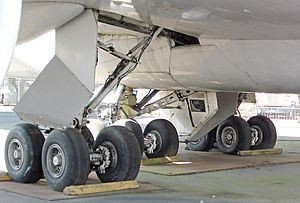
The testing was delayed because of some problems with the JT9D engines. For example, the engines would stop working if the throttles were moved too quickly. This meant that 747s could not be delivered for several months. About 20 planes were stuck at the factory waiting for new engines. On December 13, 1969, a test plane was being moved for changes. The pilot, Ralph C. Cokely, landed too early and missed the runway. One of the landing gears broke off, and two engines were damaged. However, Boeing still took the 747 to the 28th Paris Air Show in mid-1969. There, the public saw the 747 for the first time.
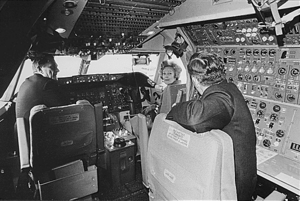
Designing the 747 and building the new factory cost a lot of money. Boeing had to borrow a huge amount of money from banks. Just before the first plane was finished, Boeing had to keep asking for more money. If they didn't get it, the company could have gone out of business. Boeing was in over $2 billion in debt. Boeing's president, William M. Allen, said, "It was really too large a project for us." However, the 747 program was a big success. Boeing was the only company making such huge planes for many years.
First Flights with Airlines
The very first time a 747 was used by an airline was on January 22, 1970. Pan Am used it to fly from New York to London. The flight was supposed to happen on the evening of January 21. But the engines on the first plane overheated. Pan Am had to find another plane, which took six hours.
The 747 did quite well when it first started flying. Some people thought that airports would not be able to handle such a big plane. But they could. There were some small problems, but they were fixed quickly. After Pan Am started using the plane, other airlines began to use their 747s too. Boeing thought that many 747s would be sold because airlines wanted a plane that could fly for a long time, not just because it was so big.
A difficult economic time in 1969-1970 was bad for Boeing. For over a year after September 1970, Boeing only sold two 747s. No 747s were sold to an American airline for over three years. Some airlines did not have enough passengers to fill the 747. So, they replaced them with smaller planes like the McDonnell Douglas DC-10 and Lockheed L-1011 TriStar. American Airlines eventually only used its 747s to carry cargo. In 1983, American Airlines gave its 747s to Pan Am. Delta Air Lines also stopped using its 747s after many years. Delta would later merge with Northwest Airlines, which did use 747s.
Flights to smaller cities became common in the 1980s. This was not good for the 747, which was designed for long, busy routes. However, many airlines still used the 747 to fly across the Pacific.
Upgrades to the 747
The first type of 747 was called the 747–100. After this, Boeing made the −100B, which could take off with more weight (higher MTOW). This meant it could carry more fuel and fly further. They also made the −100SR (Short Range), which could carry more passengers for shorter flights. In 1971, Boeing made the −200. It had better engines and could take off with even more weight. Passenger and cargo versions of the −200 were made. The 747SP (special performance) was also made and started flying in 1976.
In 1980, Boeing made the 747–300. The first 747-300 was ready in 1983. Its upper deck was longer, it flew faster, and it could hold more passengers. The −300 was first called the 747SUD for "stretched upper deck." Then it was called the 747-200 SUD, then the 747EUD, and finally it became the 747–300.
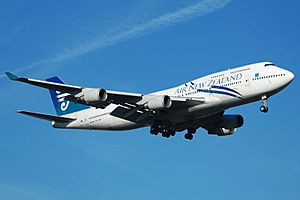
In 1985, Boeing started designing the 747-400. This type had a glass cockpit, which meant only two pilots were needed instead of three. It also had new engines and a new cabin design. The workers who made the 747-400 were not very experienced, and Boeing wanted them to work longer hours. This caused some problems with the first 747-400s. The −400 started being used by airlines in 1989.
In 1991, a 747 carried 1,087 passengers to Israel. This was part of Operation Solomon, a mission to bring people to safety. The Antonov An-225 is the world's biggest cargo plane. The Hughes H-4 Hercules has the biggest wingspan, but it only flew once.
Newer Developments
Since the 747-400 was made, Boeing suggested many more types of 747. In 1996, Boeing said they would make the 747-500X and −600X. These new planes would have cost more than US$5 billion to design and build. Airlines were not interested enough, so Boeing decided not to make them. In 2000, Boeing said it would make a 747X to compete with the Airbus A3XX. However, airlines did not like the 747X enough, so it was canceled. A year later, Boeing started focusing on the Sonic Cruiser. When the Sonic Cruiser project stopped, Boeing then focused on the Boeing 787 Dreamliner. Some of the ideas Boeing had for the 747X were used on the 747-400ER.
In 2004, Boeing said they might work on the 747 Advanced. Boeing decided to go ahead with this idea. The 747 Advanced used some features from the 787 to make the 747's design more modern. The 747 was the world's biggest passenger plane until the Airbus A380 was finished in 2007.
On November 14, 2005, Boeing announced they had changed the name of the 747 Advanced to the Boeing 747-8. The last 747-400s were made in 2009. On February 8, 2010, the 747-8 Freighter made its first flight. Cargolux received the first 747–8 in 2011. Eventually, the 747 will be replaced by a new plane called "Y3".
How the 747 is Designed
The Boeing 747 is a very large, wide-body airliner. It has four engines on its wings. The wings are swept back at 37.5 degrees, which helps the 747 fly very fast. This wing design also means the 747 doesn't need any special hangars (airplane garages).
Because the cockpit is above the main deck, it creates the plane's famous "hump." This high cockpit allows for a large cargo door to be installed at the very front of the plane.
The 747-100 can fly for 5,300 nautical miles (6,100 miles or 9,800 km). The newer 747-8i can fly even further, up to 8,000 nautical miles (9,200 miles or 14,815 km).
The 747 has special flaps on its wings. These flaps allow the 747 to fly slowly and land on regular runways. A 747 can also carry a fifth engine on its wing, but this engine is not used for flying. It's just carried as a spare part.
Types of Boeing 747s
The 747-100 was the very first type of 747, made in 1966. The 747–200, the next version, was made in 1968. The 747-300 was made in 1980, and the 747-400 was made in 1985. The newest version, the 747–8, was announced in 2005. These main types also have smaller versions. The International Civil Aviation Organization (ICAO) gives these planes short names. For example, the 747-100 is called "B741," and the 747-400 is "B744."
747-100

The first 747-100s had six windows on the upper deck. Later, airlines started using the upper deck for more passenger seats instead of just a lounge. So, Boeing made an upper deck with ten windows. Some older −100s even had the new ten-window upper deck added after they were built. The −100 used Pratt & Whitney JT9D-3A engines. Boeing did not make a special cargo version of the 747–100. However, some airlines later changed their 747-100s into cargo planes. A total of 167 747-100s were made.
747-100SR
Japanese airlines asked Boeing for a plane that could fly shorter distances but carry many passengers between big cities in Japan. So, Boeing made the -100SR (Short Range). The first -100SR began flying with Japan Air Lines (JAL) on October 7, 1973. The -100SR used General Electric CF6-45A2 or Pratt & Whitney JT9D-7A engines. Only 7 of these -100SR planes were made.
Later, Boeing designed a -100SR that could take off with more weight. This was the -100BSR. The first one was delivered to All Nippon Airways (ANA) on December 21, 1978. A total of 20 -100BSR planes were delivered to JAL and ANA.
In 1986, two -100BSR planes with the longer upper deck from the -300 series were delivered to JAL. These were the last -100SR/BSR planes ever built. The last one was delivered to JAL in September 1986. In total, 29 -100SR/BSR planes were made.
747SP
The 747SP (SP stands for "special performance") was designed because Pan Am and Iran Air both wanted a wide-body plane that could fly very long distances. For example, Pan Am wanted to fly from New York to the Middle East, and Iran Air wanted to fly from Tehran to New York. The first 747SP was built on May 19, 1975. Its first flight was on July 4, where it flew at a top speed of Mach 0.92 (about 1127 km/h). It started carrying passengers on April 25, 1976. Today, it is not used very often. A total of 45 747SP planes were made and used by airlines like Qantas, China Airlines, Air China, and South African Airways.
747-200
After the -100s were made, Boeing started making the -200. The -200 could fly longer distances but carried the same number of people. This was because airlines said the -100 couldn't fly far enough. The -200 was made in several types: a passenger version (-200B), a cargo version (-200F), a "Combi" version (which carries both cargo and people; -200M), and a "convertible" version (which can easily be changed to carry cargo; -200C).
The first -200B was finished on September 10, 1970. Its first flight was on October 11, and it started being used by KLM. Boeing then started making the other types of -200. The -200F first flew on November 30, 1971, and was delivered to Lufthansa.
The -200C first flew on March 23, 1973, and was delivered to World Airways in May of the same year. Finally, the -200M had its first flight on November 11, 1974, before being delivered to Air Canada.
In total, 393 -200 series planes were made. This includes 225 -200B, 78 -200M, 73 -200F, 13 -200C, and 4 military versions.
747-300
The 747-300 is a version of the 747–200 with a longer upper deck. It was designed to fit more passengers on the upper deck. The 747-300 also has updated General Electric CF6-80C2 engines. Besides these changes, there are not many differences between the 747-200 and 747–300. The 747-300 is 231 feet 10 inches (70.66 meters) long and has a wingspan of 195 feet 8 inches (59.64 meters).
747-400
The 747-400 was the next big update to the Boeing 747, introduced in 1989. It is the most popular type of Boeing 747 ever sold. It has many improvements over the 747-300, including new engines and special winglets (small upward-curved parts at the end of the wings). These winglets help the plane use less fuel. Its length is the same as the 747-300, but its wingspan is longer at 211 feet 5 inches (64.44 meters). The 747-400 kept the same longer upper deck as the 747-300 (except for the cargo versions). It came in six different types: the 747–400, 747-400F (Freighter), 747-400M (Combi), 747-400D (Domestic), 747-400ER (Extended Range), and the 747-400ERF (Extended Range Freighter).
747-8
The newest version of the Boeing 747 was announced in 2005 and first delivered in 2011. It has an even longer upper deck and a new "Boeing Sky Interior" inside. It also has an updated cockpit, new wings based on those from the Boeing 787 Dreamliner, and new GEnx turbofan engines. It is 250 feet (76.3 meters) long, making it the longest commercial passenger jet ever built. The 747-8 comes in two main types: the 747-8I (Intercontinental, for passengers) and the 747-8F (Freighter, for cargo).
Images for kids
-
The first 747 ever built, City of Everett, at the Museum of Flight in Seattle, Washington.
-
The first 747's main undercarriage (landing gear). It has 16 wheels!
-
First Lady Pat Nixon in a 747 cockpit on January 15, 1970.
See also
 In Spanish: Boeing 747 para niños
In Spanish: Boeing 747 para niños


